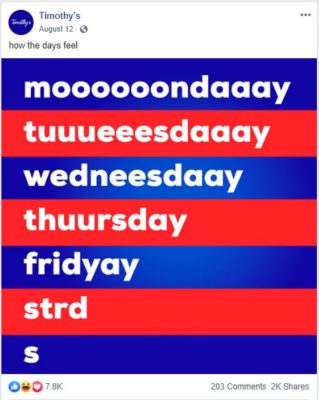5 Steps to Align Your Organic Social Media & Paid Social Media Marketing

It’s no secret that spending ad dollars is the most effective way of getting your brand message in front of users on social media. Most social platforms now require some spend for your content to reach your audience. However, the “regular posts” (or organic social content) that you add to your business’s social media presence is still an integral part of the overall marketing strategy. In fact, 57.5% of users say they’re more likely to buy from the companies that they follow on social media channels, so having a page worth connecting with is a big deal!
Here are 5 steps you can take to align your organic and paid social media marketing strategy and increase your social presence.
Create a Space to Land
Think of your business’s Facebook page, Twitter feed, or Instagram profile like a landing page on a website. When users get there, you want to give them all the information they’re looking for, which is “who you are, not just what you sell.”
Giving the user the opportunity to gather what your company is about can quickly prove that your brand is a trustworthy one that they will want to return to. Basically, create a great landing space so they will have an authentic experience when they land there.
Why go to all this trouble? Because when a new user sees a social platform advertisement and they connect with the message or the content, they may click through on the ad and land on your page. When they get there, they will expect to see more relevant content on that page. If it’s a satisfying experience, this might lead to not only them clicking through to your website and making a purchase or filling out a lead form, but it could result in them liking a post, following your page, saving a post for later, sharing with a friend, etc. which is also really valuable.
Providing users with a landing space where they can get more information or more of a feel for your brand creates an instant connection.
Create Content to Engage With
Having strong organic content that is worth engaging with not only looks good to new users when they land on your business page, but it also helps to grow your audience.

If someone likes, shares or comments on your organic social content, you can remarket to that interested user later. One click and they’re now part of the funnel. You can then choose to serve them ads based on them having engaged with or saved your content in the last 30 days, for example. It’s not specific in that you can target users based on liking a specific post (yet) but it’s still a good way to reach new people to simply remind users of your brand and that they engaged previously with it.
More and more brands are giving a nod to online humour and “memes” in their marketing. Wonder why? Well, according to a survey by Sprout Social, 3 in 4 consumers appreciate humour from brands, so posting funny things is giving people the kind of content they want to see online, and this creates a good brand connection. However, because humourous posts often get liked, commented on and shared more often, so whether they’re sponsored or not, they have the potential to reach a wide audience, leading to even more people engaging with the post. This means you can then remarket to anyone who has engaged with an organic post later with a paid ad. Organic can start small but grow to be big in a short time if the post receives strong social engagement!
Create a Consistent Look & Feel
While paid social media ads get your brand message out faster and to more people, organic does still reach your existing audience. Existing brand fans – especially those who engage often with any of your content as Facebook’s algorithm will show content to past engagers more often – will likely be served both ads and organic, so it’s important to have consistency between both. A user would likely be confused or potentially even disappointed if they were to see one message on a paid ad and a completely different one on organic (such a better price or offer, or a different launch date) which could lead to distrust of your brand.

This also ties into e-mail marketing – Having consistent messaging going out to existing customers via e-mail and on social is important, as it can really drive the message home if users are served it more than once or are reminded of it across different channels.
Using the same voice and tone across channels and across paid and organic is also important.
“Your voice, tone, and temperament should be wholly distinctive and consistent in all aspects of your brand. Wouldn’t it be odd to connect with a super familiar, warm voice on Instagram and then visit a site that’s cold and impersonal? Your customer would be confused by that kind of bait and switch, and confusion drives brand abandonment.” – Medium.com
Keep this in mind when creating ad copy vs. copy for organic posts. If your paid content has a happy, bubbly, excitable tone with plenty of exclamation marks, you don’t want your organic content to sound flat in comparison, as this could make it harder for the audience to determine what your brand voice is like and, like stated above, cause confusion from potential customers and lead to them ditching your brand.
An important final thought here is that while consistency is key, it’s crucial to not mirror organic content with paid. For ads or sponsored content, it’s acceptable to use more sales focused language (such as “sale ends soon” or “don’t miss out”), but organic content should always be less sales driven while still getting the important message out there. Coming across as too “salesly” in your organic content can lead to your brand coming off as less authentic, and authenticity is what users are looking for. “People are getting tired of anything that feels fake, over-produced or too commercial. Authentic social media marketing is about being real”.
Keep Calm: Use a Content Calendar

Creating a content calendar is essential to a strong organic strategy (and its execution!). Keeping track of posts can be overwhelming and confusing, so having a posting schedule and finding a system that works for your team for planning out content ahead of time will:
- Keep content organized and consistent
- Mitigate errors
- Make sure that important messages and announcements are accounted for and that they always make it to the social sphere
- Prevent the page from having too many or too little posts
- Serve as a space where you can keep track of what’s in market for your paid advertising and help marry up your organic content to your paid content
Having a calendar is important for keeping things organized and consistent. Having some posts mapped out ahead of time helps to get a visual of what should be posted and when, rather than attempting to create posts at the last minute or as things happen. This also helps with creating consistency. For example, if every Monday the same type of post is scheduled to go up, it’ll create a welcome sort of repetition week over week that those familiar with your brand will not only possibly come to expect, but also recognize immediately which ties in to strong brand familiarity.
A content calendar is also a great monthly or weekly representation of important content that must be shared and should not be missed. If your brand is celebrating a milestone, have a slot in the calendar for a post on social!
Having too many of the same types of posts, or not post enough, is a common mistake on organic social. Having everything planned out in a calendar can help reduce the risk of posting too much of the same thing, and also identify if your page isn’t active or posting often enough.
Lastly, and most importantly, including in your organic calendar what you’re running on paid channels or sending out in your e-mail marketing is also helpful. This helps keep track of what ads are in-market and what the message is and can be key in creating posts for organic social.
Having a content calendar also helps to create a visual representation of what is scheduled or due to be posted. It can simply help create structure and flow across your team and your channels. This leads to the final part of our strategy: creating Content Pillars.
Determine Your Content Pillars
Outlining what we call “content pillars” here at Vovia helps us create structure for organic content while also making sure posts are relevant, but also varied enough that they don’t seem too repetitive.
Having these pillars and filing content under each one can help to create diversity in posts and make sure that all aspects of your brand are properly and consistently recognized on your social platforms.
For example, if your brand has sale or promotional messaging that needs to be pushed out on a weekly basis, this would go under one pillar. But if promoting events, company milestones, or community involvement is also important to your brand, this would go under a different pillar. You could also have one for fun or viral posts, company announcements, or new product releases. Identifying what content goes under each pillar helps to ensure that each part of your brand is reflected in your posts on social media. Each pillar doesn’t have to have the same priority – one pillar could be more important or timely than another but committing to posting about each pillar consistently creates a good variety of post content as well as avoid certain things being posted too much or not enough.
Keeping your pillars in mind when creating organic posts ties everything mentioned above together: Create a space to land by maintaining a business page with diverse but consistent content. Create content to engage with that’s worth engaging with but still relevant to your brand and your pillars, while maintaining a consistent look and feel. Then keep it all organized and plan it all ahead with a Content Calendar.
The team at Vovia offers a full range of services to create, organize, schedule, maintain and grow your organic social content! Reach out to us if you think your business could use an organic overhaul.